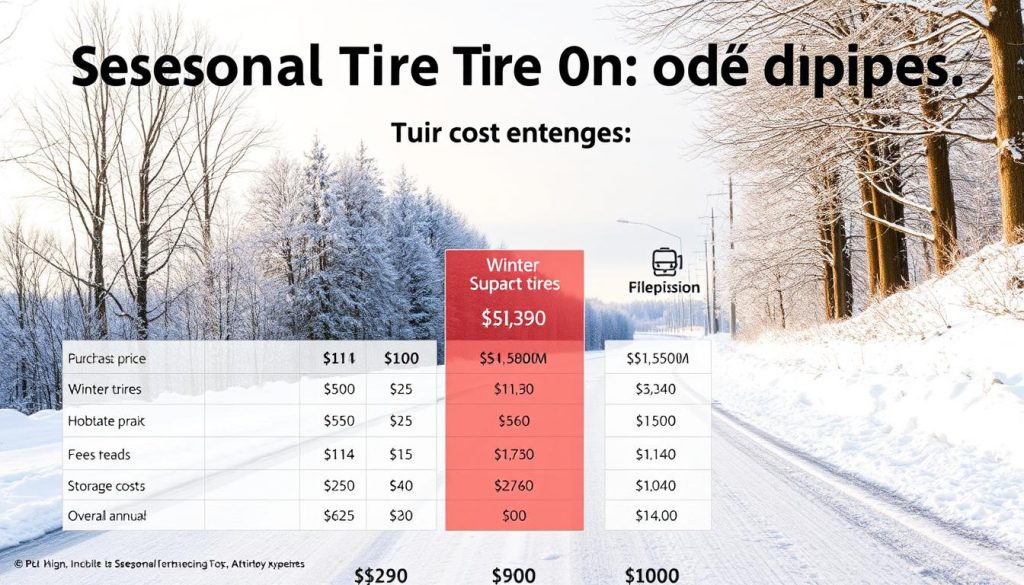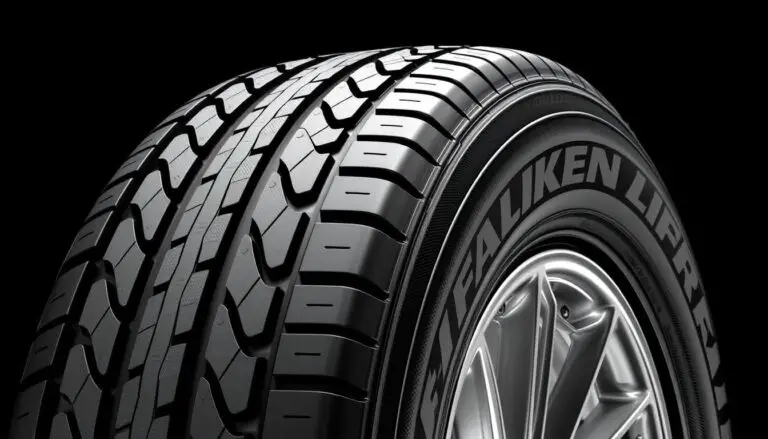As the winter season approaches, drivers are faced with a crucial decision: choosing between winter tires and all-season tires. The debate surrounding these two options centers on their performance in snowy and slushy conditions.
While all-season tires are designed to handle various road conditions, winter tires are specifically engineered for snow traction and slush handling. The question remains: which type of tire truly excels in harsh winter conditions?
Key Takeaways
- Understanding the differences between winter tires and all-season tires is crucial for safe winter driving.
- Winter tires are designed to provide superior snow traction and slush handling.
- All-season tires offer versatility but may compromise on extreme winter performance.
- The right tire choice can significantly impact vehicle handling in snowy and slushy conditions.
- Drivers should consider their specific needs and driving conditions when deciding between winter and all-season tires.
The Science of Winter Traction: Why Tire Choice Matters
The ability of tires to grip snowy or icy roads is not just a matter of tire quality but also of the underlying physics and chemistry. Winter traction is a complex interplay of various factors, including the tire’s rubber compound, tread design, and the vehicle’s speed and weight distribution.
How Temperature Affects Rubber Compounds
Rubber compounds in tires are formulated to remain flexible in cold temperatures, which is crucial for maintaining traction on snowy or icy surfaces. As temperatures drop, harder rubber compounds become less effective, while softer compounds remain pliable, providing better grip.
The Physics of Grip on Snow and Ice
The physics behind grip on snow and ice involves the interaction between the tire’s surface and the road. Tire tread patterns are designed to evacuate water and slush, allowing the tire to maintain contact with the road surface. On ice, the tire’s ability to generate friction is critical, and specialized tires can improve snow grip significantly.
Understanding Hydroplaning in Slush Conditions
Hydroplaning occurs when a tire encounters more water or slush than it can disperse, causing the tire to ride on the surface rather than grip the road. This can lead to a loss of control. Tires designed with deeper tread patterns and specialized drainage systems can mitigate this risk.
In conclusion, the science of winter traction highlights the importance of tire choice in ensuring safety on snowy and icy roads. By understanding how temperature affects rubber compounds, the physics of grip, and the risk of hydroplaning, drivers can make informed decisions about their tire needs.
Winter Tires: Engineering for Extreme Conditions
The engineering that goes into winter tires is tailored to provide optimal traction and control in harsh winter environments. This involves several key design elements that work together to enhance performance.
Specialized Rubber Compounds for Sub-Zero Temperatures
Winter tires utilize specialized rubber compounds that remain flexible in sub-zero temperatures, ensuring better grip on snowy and icy roads. These compounds are designed to harden in warmer temperatures, which can lead to faster wear during non-winter months.
Advanced Tread Patterns and Siping Technology
The tread patterns on winter tires are designed to maximize traction by incorporating deeper treads and unique patterns that help to evacuate snow and slush. Siping technology, which involves creating small slits in the tire surface, further enhances grip by providing additional biting edges on snow and ice.
The Three-Peak Mountain Snowflake Certification Standard
To ensure a tire meets rigorous winter performance standards, it must achieve the Three-Peak Mountain Snowflake certification. This involves passing severe snow service tests, verifying the tire’s capability in extreme winter conditions. For more information on winter tire certifications and comparisons with other tire types, visit SimpleTire’s guide.
By combining these advanced features, winter tires provide drivers with the confidence to navigate through challenging winter conditions safely.
All-Season Tires: The Compromise Solution
For many drivers, all-season tires represent a practical choice, balancing the needs of daily driving with occasional winter conditions. These tires are designed to provide a versatile solution, handling a variety of road conditions without the need for seasonal changes.
Year-Round Performance Design Philosophy
All-season tires embody a design philosophy that prioritizes flexibility and adaptability. They are engineered to deliver acceptable performance across a broad spectrum of temperatures and road surfaces. This is achieved through a combination of specialized rubber compounds and tread patterns that can handle dry roads, rain, and light snow.
Temperature Thresholds and Performance Degradation
One of the critical aspects of all-season tires is their performance at different temperature thresholds. As temperatures drop, the rubber compound of all-season tires becomes less effective, leading to a degradation in performance. This is particularly noticeable in extreme cold, where the tires may not provide the same level of grip as dedicated winter tires.
- Temperature Range: All-season tires typically perform well in moderate temperatures, but their effectiveness diminishes in very cold or very hot conditions.
- Performance Degradation: The degradation in performance is due to the tire’s rubber compound becoming harder in cold temperatures, reducing traction.
M+S Rating vs. True Winter Certification
The M+S rating is often misunderstood as a guarantee of winter performance. However, it simply indicates that the tire meets certain criteria for mud and snow traction. True winter certification, marked by the Three-Peak Mountain Snowflake symbol, signifies that a tire has passed more rigorous tests for snow performance.
All-season tires may carry an M+S rating, but they rarely achieve true winter certification. Drivers should be aware of these distinctions when choosing tires, especially if they frequently drive in snowy or icy conditions.
Winter Tires vs All Seasons Tires: Who Really Handles Better in Slush and Snow?
Snowy and slushy conditions put tire capabilities to the test, raising the question: which is better, winter tires or all-season tires? The answer lies in a detailed comparison of their performance in critical areas.
Braking Distance Comparisons on Snow-Covered Roads
One of the most crucial factors in winter driving is braking distance. Winter tires are specifically designed to provide better grip on snowy and icy roads, resulting in shorter stopping distances. In contrast, all-season tires tend to harden in cold temperatures, leading to longer braking distances.
Studies have shown that winter tires can reduce braking distance by up to 30% compared to all-season tires on snowy roads.
Cornering Stability and Handling Tests
Cornering stability is another vital aspect of vehicle safety during winter. Winter tires maintain their flexibility and grip even in cold conditions, allowing for more stable cornering. All-season tires, while capable, do not match the performance of winter tires in this regard.
Independent tests have demonstrated that vehicles equipped with winter tires exhibit less understeer and maintain better control during cornering maneuvers on snowy roads.
Acceleration and Uphill Traction Measurements
When it comes to accelerating or climbing uphill on snowy or slushy roads, the difference between winter and all-season tires becomes apparent. Winter tires provide superior traction, enabling smoother acceleration and better control uphill.
Test Results from Independent Testing Organizations
Several independent testing organizations have conducted rigorous tests to compare the performance of winter tires and all-season tires. The results are compelling.
| Tire Type | Braking Distance (meters) | Cornering Stability (score) | Acceleration (seconds) |
|---|---|---|---|
| Winter Tires | 35 | 8.5 | 5.2 |
| All-Season Tires | 50 | 6.2 | 7.1 |
The data clearly indicates that winter tires outperform all-season tires in snowy and slushy conditions, making them the safer choice for drivers who frequently encounter such conditions.
Performance Analysis in Specific Winter Conditions
When winter conditions hit, the performance of your tires can make all the difference in safety and control. Drivers need to understand how their tires will behave in various winter scenarios, from deep snow to icy roads.
Deep Snow Performance Differences
Winter tires are specifically designed to handle deep snow with their unique tread patterns and rubber compounds that stay flexible in cold temperatures. In contrast, all-season tires may struggle to provide the same level of traction and control in deep snow due to their harder rubber compounds.
Slush and Wet Snow Handling Capabilities
In slush and wet snow conditions, the ability of a tire to evacuate water and maintain contact with the road surface is crucial. Winter tires are engineered with specialized tread designs that improve their performance in these conditions, offering better handling and braking capabilities compared to all-season tires.
Ice and Black Ice Traction Comparison
Ice and black ice pose significant challenges for drivers. Winter tires, with their specialized tread compounds and siping technology, provide superior traction on icy surfaces. All-season tires, while capable, often fall short in providing the same level of grip and control on ice.
Real-World Driver Experiences
Many drivers have shared their experiences with both winter and all-season tires. For instance, a driver from Minnesota reported that switching to winter tires significantly improved their ability to navigate snowy and icy roads. Another driver from New York noted that while all-season tires were sufficient for occasional snow, they lacked the confidence that winter tires provided during prolonged winter conditions.
| Tire Type | Deep Snow | Slush/Wet Snow | Ice/Black Ice |
|---|---|---|---|
| Winter Tires | Excellent | Very Good | Excellent |
| All-Season Tires | Good | Good | Fair |
The Economics of Seasonal Tire Changes
When considering seasonal tire changes, the economic implications play a significant role in the decision-making process. The choice between winter tires and all-season tires involves not only performance differences but also significant financial considerations.
Initial Investment: Purchase Price Comparison
The initial cost of winter tires is typically higher than that of all-season tires. This is due to the specialized materials and tread designs that enhance their performance in snowy and icy conditions. For instance, a set of winter tires can cost between $800 to $1,200 for a typical sedan, while all-season tires might range from $500 to $900 for the same vehicle.

Long-Term Cost Analysis Including Extended Tire Life
While the initial investment in winter tires may be higher, their long-term cost-effectiveness should also be considered. By switching between winter and all-season tires seasonally, drivers can potentially extend the life of both sets of tires. All-season tires, when used year-round, may wear out faster due to the compromise in their design. A study found that drivers who switched between winter and all-season tires saw a 20% increase in the overall lifespan of their tires.
Insurance Considerations and Accident Prevention Value
Some insurance companies offer discounts to drivers who use winter tires, as they are associated with a reduced risk of accidents during winter conditions. The exact discount varies by insurer, but it can range from 5% to 10% off premiums. This can help offset the higher initial cost of winter tires over time.
Winter Tire Maintenance and Best Practices
Effective winter tire maintenance involves a combination of storage, pressure monitoring, and rotation. To ensure your winter tires perform optimally and last longer, it’s crucial to follow best practices.
Proper Storage During Off-Season
When the winter season ends, storing your tires properly is vital. Keep them in a cool, dry place away from direct sunlight. Remove dirt and debris before storage to prevent damage. It’s also recommended to store tires in breathable bags to maintain their condition.
Pressure Monitoring in Fluctuating Temperatures
Monitoring tire pressure is critical, especially during temperature fluctuations. For every 10°F change, tire pressure can increase or decrease by about 1 PSI. Check tire pressure monthly and adjust according to the manufacturer’s recommendations. Proper pressure ensures optimal traction and safety.
Rotation Patterns for Even Wear
Regular rotation of winter tires is essential for even wear. Follow the recommended rotation pattern for your vehicle, typically every 5,000 to 8,000 miles. This practice not only extends the life of your tires but also maintains their performance and handling.
Regional Considerations for American Drivers
The United States encompasses a wide range of climates, making regional tire recommendations crucial for safe winter driving. Drivers across the country face unique challenges based on their geographical location.
Tire Recommendations for Different U.S. Climate Zones
America’s diverse climate zones demand different tire specifications. For instance, the northern states experience harsh winters with significant snowfall, necessitating tires with advanced snow traction capabilities. In contrast, southern states have milder winters, potentially allowing for all-season tires.
| Climate Zone | Recommended Tire Type | Key Features |
|---|---|---|
| Northern States | Winter Tires | Deep tread, snow-specific compounds |
| Southern States | All-Season Tires | Balanced performance, wet traction |
| Mountainous Regions | Winter Tires with Chains | Enhanced grip, chain compatibility |
Urban vs. Rural Winter Driving Requirements
Urban and rural driving environments present different challenges. Urban areas often have better road maintenance, potentially reducing the need for extreme winter tires. Rural areas, however, may require tires that can handle unplowed roads and deeper snow.

State-Specific Regulations and Chain Laws
Some states have specific regulations regarding tire chains and winter equipment. For example, California requires tire chains in certain mountainous areas during heavy snowfall. Understanding these regulations is crucial for compliance and safety.
In conclusion, American drivers must consider their regional climate, driving conditions, and local regulations when selecting winter tires. By doing so, they can ensure safer winter driving experiences.
Debunking Common Winter Tire Myths
Winter tire myths are rampant, and it’s time to set the record straight. Many drivers hold beliefs about winter tires that are not entirely accurate, potentially putting them at risk during winter driving conditions.
The AWD/4WD Misconception
One common myth is that vehicles equipped with All-Wheel Drive (AWD) or Four-Wheel Drive (4WD) don’t need winter tires. While AWD and 4WD systems can improve traction, they don’t stop as effectively on snowy or icy roads without winter tires. Winter tires are essential for improving stopping power and overall safety, regardless of your vehicle’s drivetrain.
The “I’ve Never Had a Problem” Fallacy
Some drivers believe that because they’ve never had a problem driving in winter conditions, they don’t need winter tires. However, this complacency can be dangerous. Winter tires provide critical safety benefits, even for experienced drivers. They improve handling and reduce stopping distances on snowy and icy roads, which can be the difference between safety and accident.
All-Weather Tires: A True Middle Ground?
All-weather tires are often presented as a compromise between winter and all-season tires. While they offer better performance in cold conditions than all-season tires, they may not provide the same level of traction as dedicated winter tires. Drivers should weigh the benefits and limitations of all-weather tires based on their specific needs and driving conditions.
Conclusion: Making the Safest Choice for Winter Driving
Choosing the right tires for winter driving is crucial for vehicle safety and performance. The comparison between winter tires and all-season tires highlights significant differences in their ability to handle snowy and icy roads.
For drivers who frequently encounter harsh winter conditions, winter tires are the safest choice, offering superior traction and control. They provide better grip and shorter braking distances on snow and ice due to their specialized rubber compounds and advanced tread patterns, enhancing overall tire safety.
Drivers who prioritize safety and optimal performance during winter months should consider investing in winter tires. To learn more about the differences between tire models, such as the Continental CrossContact LX25 and Michelin CrossClimate 2, visit this comparison.
Making an informed decision about tire choice can significantly impact safety on the roads during winter driving. By understanding the strengths and limitations of different tire types, drivers can stay safe and in control.
FAQ
What is the main difference between winter tires and all-season tires?
Winter tires are specifically designed to provide better traction, braking, and handling in snowy and icy conditions, whereas all-season tires are a compromise solution for year-round driving, sacrificing some winter performance for better dry and wet road handling.
How do temperature thresholds affect all-season tire performance?
All-season tires tend to degrade in performance as temperatures drop below certain thresholds, typically around 45°F (7°C), whereas winter tires remain effective in sub-zero temperatures.
What is the significance of the Three-Peak Mountain Snowflake certification?
The Three-Peak Mountain Snowflake certification is a standard that indicates a tire has met specific performance requirements for snow traction, ensuring it provides a certain level of winter driving capability.
Are all-weather tires a viable alternative to winter tires?
All-weather tires can be a compromise between winter and all-season tires, offering a balance of performance in various conditions, but may not match the extreme winter capabilities of dedicated winter tires.
How do I properly store my winter tires during the off-season?
To store winter tires, clean them thoroughly, dry them, and store them in a cool, dry place, away from direct sunlight, and ideally in a breathable bag or container to maintain their condition.
What are the benefits of using winter tires in terms of insurance and accident prevention?
Using winter tires can potentially reduce the risk of accidents, which may lead to lower insurance premiums or other benefits, as some insurance companies offer discounts for safety features or practices that reduce risk.
How do regional climate zones in the U.S. affect tire recommendations?
Different U.S. climate zones have varying winter driving requirements; for example, areas with harsher winters may necessitate winter tires, while regions with milder winters might be adequately served by all-season or all-weather tires.
Do AWD or 4WD vehicles eliminate the need for winter tires?
No, having AWD or 4WD does not eliminate the need for winter tires, as these systems primarily aid in acceleration, not braking or cornering, where winter tires provide significant benefits.
What is hydroplaning, and how do tires handle it in slush conditions?
Hydroplaning occurs when a tire encounters more water than it can scatter, leading to loss of traction; tires with specific tread patterns and siping technology can better handle hydroplaning in slushy conditions.
How often should I check my winter tire pressure?
It’s essential to check winter tire pressure regularly, ideally monthly, as tire pressure can fluctuate with temperature changes, affecting tire performance and safety.


